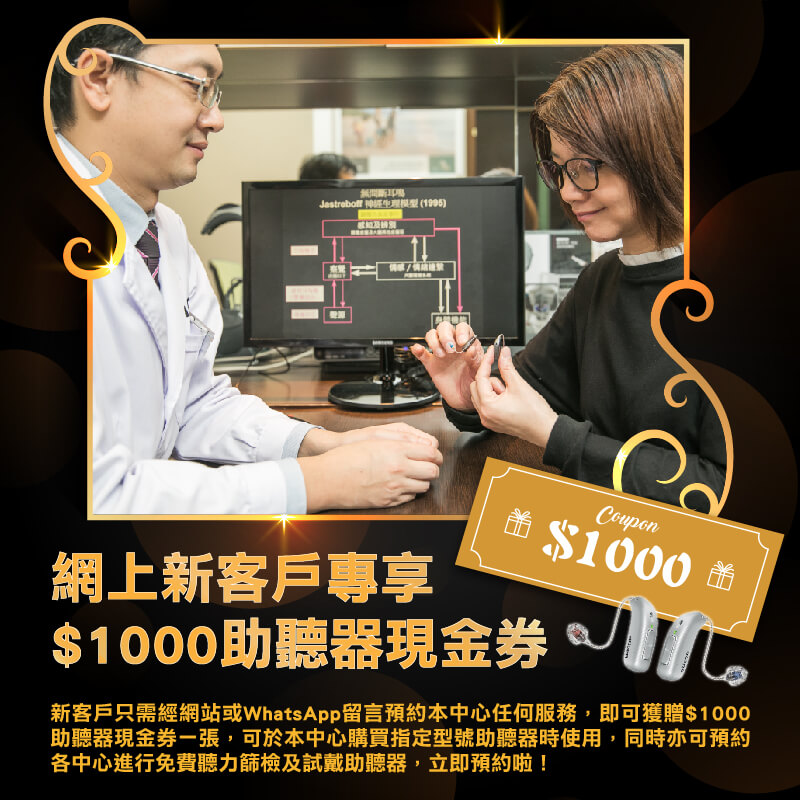Understanding Your Hearing
Understanding Your Hearing
The consequences of hearing loss can be very serious if hearing loss remain untreated. We continuously work on client’s hearing status, preferences and lifestyle to prescribe the most appropriate hearing instruments for them. We provide professional hearing assessment services, which include:
Purpose:Aims to determine the type and degree of hearing loss of older children (5 years +) and adults through obtaining ear- and frequency-specific information.
Procedure:Test is performed in a sound-controlled environment. Client is required to listen to various pure tones (250 – 8k Hz) at different volumes. Every time a sound is heard, the client is required to provide a response indicating it was audible, such as raising his or her hand, or pushing a button.
Purpose:Test includes tympanometry and/or acoustic reflex measures, aims to assess conditions of the tympanic membrane and middle ear system.
Procedure:In tympanometry testing, the amount of sound reflected by the eardrum is measured by a probe in the ear canal as the pressure in the ear canal is varied. In acoustic reflex measures, high-intensity sound stimuli are presented to check involuntary muscle contractions
Purpose:Aims to assess cochlear outer hair cell functioning amongst infants and adults
Procedure:A series of sounds are presented to the client’s ear canal via a small probe, in order to check if the cochlea produces responses to these sounds. Data collected will be analyzed by a computer program.
Purpose:Aims to estimate hearing sensitivity and to identify neurological abnormalities of the auditory nerve and the auditory pathway up through the brainstem. The test is applicable to infants, children and adults.
Procedure:The client is required to be in a sleeping or relaxed state. Electrodes are placed on the head, and brain wave activity in response to sound is recorded.
Purpose:Aims to evaluate client’s (adult) ability to discriminate speech in English or Chinese.
Procedure:A series of words at different intensity levels are presented to the ear via headphones. The client is required to repeat what he or she has heard.
Purpose:Aims to assess one’s hearing level for frequencies between 9k – 20k Hz
Procedure:Test is performed in a sound-controlled environment. Client is required to listen to high frequency pure tones (9k – 20k Hz) at different volumes. Every time a sound is heard, the client is required to provide a response indicating it was audible, such as raising his or her hand, or pushing a button.
Purpose:
| Otoscopy | Evaluate ear canal and ear drum status |
| Pure Tone Audiometry | Assess the hearing sensitivity and nature of impairment (if any) |
| Otoacoustic Emissions | Assess the inner ear cochlear outer hair cell function |
| Tinnitus Pitch Matching | To approximate the pitch of the tinnitus |
| Tinnitus Loudness Matching | To closely match tinnitus loudness |
| Minimum Masking Level Determination | To verify whether tinnitus is maskable |
| Loudness Discomfort Level Determination | Access loudness tolerance levels |
The goal of tinnitus management (or tinnitus retraining therapy) is not to eliminate tinnitus but to relief physiological and psychological symptoms such as insomnia, distraction at work, depressed mood etc., caused by tinnitus. Length of tinnitus rehabilitation lasts from 6 to 12 months, which varies among individual. As soon as one no longer annoyed by his or her tinnitus, the rehabilitation sessions could be discontinued.
Audiologists would conduct tinnitus evaluation for chronic tinnitus suffers and customized an individualized management plan for each patient. Below are some of the management methods:
For tinnitus suffers with mild hearing impairment, they are not able to hear soft sounds which leads to narrowed soundscape, making tinnitus sounds louder. As for those with severe hearing impairment who could barely hear daily sounds, they live in a quiet world and lead to a louder perception of their tinnitus. Sound therapy is a common way for tinnitus relief.
For normal hearing individual or hearing aid user still annoyed by their tinnitus, audiologist may suggest the use of tinnitus masker function in hearing aid. This function allows the play of broadband noise (white, red or pink noise) or sounds of tidal waves to further enrich the soundscape. Base on the findings from tinnitus evaluation, audiologist would prescribe a type of sound that suffers prefer at appropriate volume to distract one from their tinnitus. Some models of hearing aid are compatible with app on smart phone which allows user to adjust the volume of masker as needed.
Alternatively, playing external sound sources suffers like or interested in (delivered through mobile app, radio, table sound generator, pillow player etc.) to reduce the tinnitus to background sound ratio, with a view to alleviate mental alertness and induce distraction to better concentrate at work or easier to fall into sleep at night.

